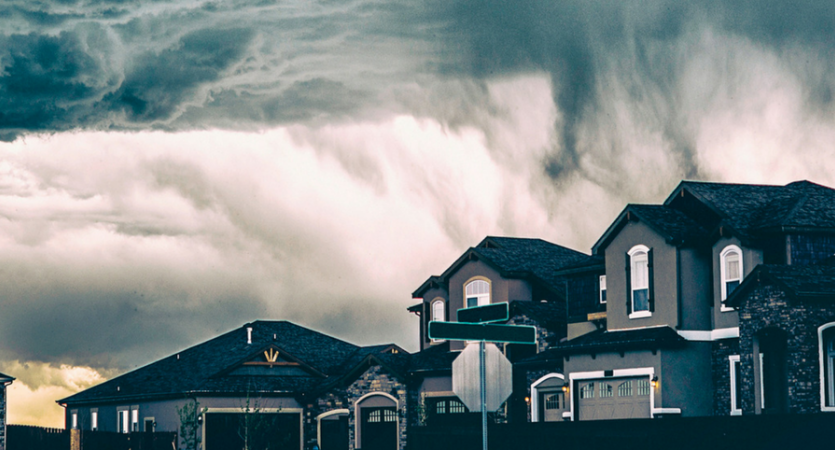Ready to relocate to a new region of the country? Consider the local weather, particularly when you evaluate your home insurance options.
Home insurance is a must-have, regardless of where your house is located. With the right coverage in place, you can safeguard your house and personal belongings against many natural disasters. But not all home insurance policies are created equal. As such, coverage that works for a homeowner in a hot, humid climate is unlikely to meet the needs of a homeowner who deals with excess snow, ice and other inclement winter weather.
To better understand the link between home insurance and weather, let’s consider a few examples.

Southern California experiences roughly 10,000 earthquakes annually, so a Southern California homeowner should have sufficient coverage to protect his or her house and personal belongings against damage or destruction that takes place due to an earthquake. However, Atlantic Coast homes may be susceptible to hurricane storm surge flooding that is not covered by a standard homeowners insurance policy.
If you’re moving to a new area of the country, it may seem simple to transfer your existing home insurance coverage to your new residence. Yet doing so could leave you without coverage against natural disasters that may be more likely to affect you as a homeowner in a new region.
Here are five tips that you can use to purchase the right home insurance if you’re moving to an area with unfamiliar weather:
- Understand What’s Covered by a Standard Home Insurance Policy
A standard homeowners policy offers the following coverage:
- Dwelling: Ensures you can repair or rebuild your home if it is damaged by a covered cause of loss. For homeowners, it is paramount to have dwelling protection to cover the full cost of home repairs or a complete home rebuild.
- Other Structures: Offers coverage against damage or destruction of garages, sheds and other detached structures on your property.
- Personal Property: Provides reimbursement for clothing, electronics and other personal items in your home that have been damaged or destroyed by a covered cause of loss.
- Loss of Use: Covers the costs associated with housing and assorted living expenses if you’re forced to move out of your residence while it is being rebuilt or repaired.
- Liability: Helps safeguard your assets and covers various legal defense expenses if you face a lawsuit because you or a family member caused damage or injuries to other people on or off your property.
Dedicate the necessary time and resources to learn about your current homeowners coverage – you’ll be glad you did. As an informed homeowner, you can review numerous coverage options and choose the right coverage based on your home’s location. Don’t forget to discuss your home insurance needs with an independent agent. With an insurance professional at your side, you can explore a wide range of coverage options and select a home insurance policy that will match or surpass your expectations.
- Find Out What’s Not Covered by a Home Insurance Policy
A standard homeowners policy is not always a surefire solution to all of your coverage needs. In fact, some of the weather-related problems that are not covered by a traditional homeowners policy include:
- Earthquakes: If an individual requires earthquake coverage, he or she may need to purchase a supplemental insurance policy.
- Floods: Flood insurance can be purchased from the National Flood Insurance Program (NFIP), which offers both home and personal property coverage if your home is damaged or destroyed due to flooding.
- Hurricanes: In some instances, you may need to purchase additional flood and windstorm insurance to guarantee that you’re fully protected against hurricanes.
- Mechanical Breakdown: If your car breaks down while you’re traveling to a new home in unfamiliar weather, mechanical breakdown insurance (MBI) is available to cover bad brakes, transmission issues and other major vehicle system malfunctions.
- Tornadoes: Many tornadoes are accompanied by powerful winds that can damage fences and other structures on your property, but it is important to note that a standard homeowners policy only provides limited coverage for this type of property damage.
- Water Damage: Hail and ice damage commonly are covered by home insurance, but water damage limits may vary.
When in doubt, it is always better to err on the side of caution. If you’re unsure if a weather-related issue is covered by your homeowners policy, don’t hesitate to reach out to an agent for extra assistance.
- Contact Your State Insurance Commissioner
The National Association of Insurance Commissioners (NAIC) helps state regulators protect the interests of insurance consumers, including those who are relocating to a new region of the country. This association also provides many valuable resources to help you discover the right home insurance policy based on your home’s location.
For instance, the NAIC offers a guide to shopping for homeowners insurance. This guide helps homeowners understand various declarations and basic insurance terms to ensure an individual can choose the ideal coverage.
You can always reach out to your state’s insurance commissioner to provide honest, unbiased recommendations about homeowners coverage, and can help you make sense of home insurance information that is not clear.
- Know the Cost of Home Insurance
What you’re paying for home insurance today may increase if you need to upgrade your homeowners coverage based on an upcoming move to a location with unfamiliar weather. Those who plan ahead for the increased cost of home insurance will ensure they can afford the coverage they need at a new location.
The Federal Reserve Board estimates the average homeowner spends between $300 and $1,300 per year on home insurance at an average coverage rate of $3.50 per $1,000, according to Zacks. At the same time, it is essential to note the cost of home insurance may increase based on a number of risks that extend beyond natural disasters. These include:
- Attractive Nuisances: Swimming pools, trampolines and other “attractive nuisances” may force you to pay more than other homeowners for home insurance.
- Proximity to a Fire Station: Those who live close to a fire station may be eligible for lower home insurance premiums than others.
- Your Dog: Some insurance providers won’t offer full homeowners coverage if you own certain dog breeds.
- Shop Around for the Right Coverage
If you’re moving to a location with unfamiliar weather and need to buy home insurance, why should you be forced to settle for subpar coverage? Instead, shop around for home insurance, and you can purchase the ideal coverage at the best possible price.
The right insurance company should boast plenty of industry experience, a proven reputation and best-in-class customer support. Plus, this insurance provider will employ friendly, knowledgeable professionals who are happy to respond to any home insurance queries.
No one should be forced to overspend to insure their home and personal belongings. But with the right insurance company at your disposal, you can minimize your risks without having to worry about breaking your budget.
Lastly, an independent insurance agent can help you obtain the optimal coverage based on your location. This insurance professional can teach you about assorted home insurance options and help you make informed coverage decisions.
Take the guesswork out of getting the homeowners coverage you need at a new location. By using these tips, you can move one step closer to acquiring the right coverage any time you choose.






